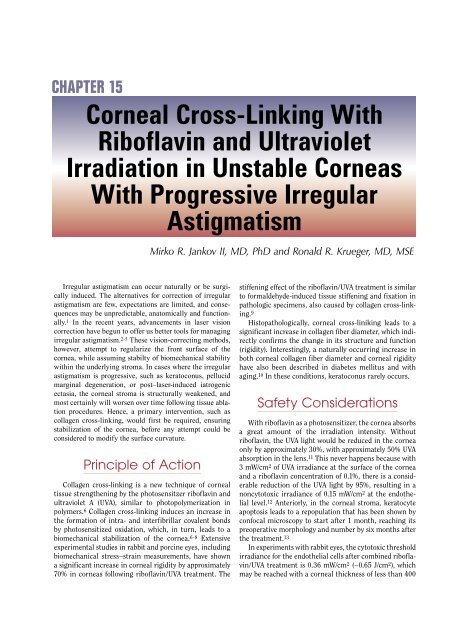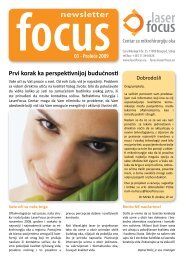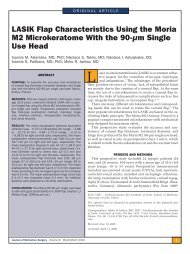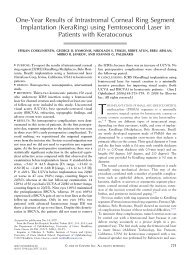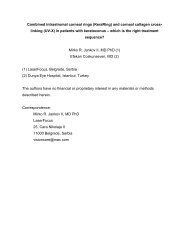Jankov II MR, Krueger R. Corneal cross-linking with ... - LaserFocus
Jankov II MR, Krueger R. Corneal cross-linking with ... - LaserFocus
Jankov II MR, Krueger R. Corneal cross-linking with ... - LaserFocus
Create successful ePaper yourself
Turn your PDF publications into a flip-book with our unique Google optimized e-Paper software.
CHAPTER 15<strong>Corneal</strong> Cross-Linking WithRiboflavin and UltravioletIrradiation in Unstable CorneasWith Progressive IrregularAstigmatismMirko R. <strong>Jankov</strong> <strong>II</strong>, MD, PhD and Ronald R. <strong>Krueger</strong>, MD, MSEIrregular astigmatism can occur naturally or be surgicallyinduced. The alternatives for correction of irregularastigmatism are few, expectations are limited, and consequencesmay be unpredictable, anatomically and functionally.1 In the recent years, advancements in laser visioncorrection have begun to offer us better tools for managingirregular astigmatism. 2-5 These vision-correcting methods,however, attempt to regularize the front surface of thecornea, while assuming stabilty of biomechanical stability<strong>with</strong>in the underlying stroma. In cases where the irregularastigmatism is progressive, such as keratoconus, pellucidmarginal degeneration, or post–laser-induced iatrogenicectasia, the corneal stroma is structurally weakened, andmost certainly will worsen over time following tissue ablationprocedures. Hence, a primary intervention, such ascollagen <strong>cross</strong>-<strong>linking</strong>, would first be required, ensuringstabilization of the cornea, before any attempt could beconsidered to modify the surface curvature.Principle of ActionCollagen <strong>cross</strong>-<strong>linking</strong> is a new technique of cornealtissue strengthening by the photosensitzer riboflavin andultraviolet A (UVA), similar to photopolymerization inpolymers. 6 Collagen <strong>cross</strong>-<strong>linking</strong> induces an increase inthe formation of intra- and interfibrillar covalent bondsby photosensitized oxidation, which, in turn, leads to abiomechanical stabilization of the cornea. 6-8 Extensiveexperimental studies in rabbit and porcine eyes, includingbiomechanical stress–strain measurements, have showna significant increase in corneal rigidity by approximately70% in corneas following riboflavin/UVA treatment. Thestiffening effect of the riboflavin/UVA treatment is similarto formaldehyde-induced tissue stiffening and fixation inpathologic specimens, also caused by collagen <strong>cross</strong>-<strong>linking</strong>.9Histopathologically, corneal <strong>cross</strong>-liniking leads to asignificant increase in collagen fiber diameter, which indirectlyconfirms the change in its structure and function(rigidity). Interestingly, a naturally occurring increase inboth corneal collagen fiber diameter and corneal rigidityhave also been described in diabetes mellitus and <strong>with</strong>aging. 10 In these conditions, keratoconus rarely occurs.Safety ConsiderationsWith riboflavin as a photosensitizer, the cornea absorbsa great amount of the irradiation intensity. Withoutriboflavin, the UVA light would be reduced in the corneaonly by approximately 30%, <strong>with</strong> approximately 50% UVAabsorption in the lens. 11 This never happens because <strong>with</strong>3 mW/cm 2 of UVA irradiance at the surface of the corneaand a riboflavin concentration of 0.1%, there is a considerablereduction of the UVA light by 95%, resulting in anoncytotoxic irradiance of 0.15 mW/cm 2 at the endotheliallevel. 12 Anteriorly, in the corneal stroma, keratocyteapoptosis leads to a repopulation that has been shown byconfocal microscopy to start after 1 month, reaching itspreoperative morphology and number by six months afterthe treatment. 13In experiments <strong>with</strong> rabbit eyes, the cytotoxic thresholdirradiance for the endothelial cells after combined riboflavin/UVAtreatment is 0.36 mW/cm 2 (~0.65 J/cm 2 ), whichmay be reached <strong>with</strong> a corneal thickness of less than 400
160 Chapter 15Figure 15-1. Treatment in progress <strong>with</strong> the cornea soaked<strong>with</strong> riboflavin and irradiated by the UV lamp. In the lowerright corner, one can appreciate the patient’s perspective ofthe UV lamp.µm using 3 mW/cm 2 irradiance (~5.4 J/cm 2 ) at the cornealfront surface. 14 Therefore, preoperative pachymetry isessential and must be measured in all cases. Usually, thecentral corneal thickness in keratoconus is not reducedto less than 400 µm. In corneas <strong>with</strong> less then 400 µm,the <strong>cross</strong>-<strong>linking</strong> treatment should be avoided using thesedosage parameters, and a hypotonic solution of riboflavinin physiological solution (<strong>with</strong>out Dextran T-500) shouldbe applied in order to swell the cornea before and duringthe irradiation.Considering the crystalline lens, the UVA dose of 0.65J/cm 2 (0.36 mW/cm 2 ) is far below a cataractogenous levelof 70 J/cm 2 . 15 In addition, lens damage is usually inducedby UVB light (wavelength range of 290 to 320 nm), whichhas a higher energy than UVA. Regarding retinal phototoxicity,UVA levels in the posterior segment are negligibleand comparable to ambient sun exposure.Surgical TechniqueThe procedure should be conducted under sterileconditions in the operating room. Topical anesthetic isapplied and the central 7 mm of the corneal epitheliumis removed using a blunt knife, or 30 s of application of20% alcohol. As a photosensitizer, riboflavin 0.1% solutionin Dextran T-500 20% solution is applied 15 minutesbefore the irradiation and every 2 to 3 minutes duringthe irradiation. Alternatively, a smaller area of epitheliummay be removed, provided that the time of application ofriboflavin is increased, and the presence of riboflavin inthe anterior chamber is confirmed by the presence of ayellow flare under the slit-lamp examination prior to theapplication of UVA light.After allowing riboflavin to permeate through the corneainto the anterior chamber, the irradiation is startedFigure 15-2. Fluorescence of the riboflavin under the UV lightindicates active treatment application.using a UV lamp (370 nm; Peschkemed, Huenenberg,Switzerland) at a 1-cm working distance for 30 minutesusing a 3 mW/cm 2 irradiance (~5.4 J/cm 2 ) (Figures 15-1and 15-2). After the treatment, an antibiotic eyedrop isapplied, and a bandage contact lens is fitted to the cornealsurface until reepithelialization.Indications and ClinicalResultsThe principle indication for the use of the collagen<strong>cross</strong>-<strong>linking</strong> of the cornea is to halt the procession ofectasia in diseases of the cornea, such as keratoconusand pellucid marginal degeneration. Collagen <strong>cross</strong>-<strong>linking</strong>may also be effective in the treatment and prophylaxisof iatrogenic keratectasia, resulting from laser insitu keratomileusis (LASIK). Beyond keratoectasia, thenew technique can also be used in treating corneal meltingconditions or infectious keratitis, as the <strong>cross</strong>-<strong>linking</strong>strengthens a collagenolytic cornea and UVA irradiationsterilizes the infectious agent.The first prospectively controlled clinical study thatincluded 23 eyes <strong>with</strong> moderate or advanced progressivekeratoconus showed collagen <strong>cross</strong>-<strong>linking</strong> as effective inhalting the progression of keratoconus over a period of upto 4 years. 15 In the study, a mean preoperative progressionof keratometry (max K) by 1.42 diopters (D) in 52%of eyes over a 6-month period was followed by a postoperativedecrease in 70% of eyes, revealing a reduction ofmean keratometry by 2.01 D. Moreover, the postoperativespherical equivalent (SEQ) was reduced by an average of1.14 D, whereas at the same time, 22% of the untreatedfellow control eyes had a postoperative progression ofkeratectasia by 1.48 D.Clinical studies carried out elsewhere and presentedat the 1st and 2nd International Congress of <strong>Corneal</strong>
<strong>Corneal</strong> Cross-Linking With Riboflavin and Ultraviolet Irradiation in Unstable Corneas 161Figure 15-3. Third postoperative day: right after the removal ofthe contact lens one can observe transient stromal and epithelialedema <strong>with</strong> a mild cotton-like hazy appearance <strong>with</strong>in thecorneal stroma. (Courtesy of T. Seiler, MD PhD.)Cross Linking in 2005 and 2006 showed similar findings.The prospective results from our group in Serbia for 38keratoconic eyes of 19 patients, where the more advancedeye was treated and the fellow eye served as a control,showed a 6-month postoperative statistically significantmean decrease in max K by 1.75 ± 1.24 D, SEQ by 1.94± 3.30 D, and refractive cylinder by 1.31 ± 1.96 in thetreated eyes, whereas the fellow eyes had a mean increasein max K by 0.24 ± 0.97 D, SEQ by 0.13 ± 1.00 D, andcylinder by 0.06 ± 0.83 (P < 0.01). Both the uncorrectedvisual acuity (UCVA) and best spectacle-corrected visualacuity (BSCVA) increased by 0.01 ± 0.12 and 0.04 ± 0.22,respectively, in the treated eyes, whereas the fellow eyesdecreased by 0.03 ± 0.23 and 0.02 ± 0.17, respectively,but <strong>with</strong>out statistically significant difference. Regardingsafety, the endothelial cell counts decreased by 64 ± 158c/mm 2 in the treated eyes and 20 ± 44 c/mm 2 in the felloweyes <strong>with</strong>out reaching statistical significance. Meanwhilethe IOP increased by 1.92 ± 2.22 mm Hg in the treatedeyes and 0.08 ± 2.25 mm Hg in the fellow eyes <strong>with</strong> a highstatistically significant difference (P
162 Chapter 15Figure 15-5. Under the slit lamp a faint demarcation linebetween the swollen anterior and normal posterior cornea canbe seen on the third day (left). This line can hardly be seen after3 months (right). (Courtesy of T. Seiler, MD PhD.)Figure 15-4. Tangential topographic maps illustrate improvementsin corneal topography: (1) immediately after the removalof the contact lens (upper left); 2) 1 month after the removalof the contact lens (upper right), corneal <strong>cross</strong>-<strong>linking</strong> wasperformed; (3) 5 months after corneal <strong>cross</strong>-<strong>linking</strong> (lower left),topography-guided photorefractive keratectomy (PRK) <strong>with</strong>T-CAT WaveLight Allegretto Wave was performed; and 4) 4months after topography-guided PRK (lower right).ConclusionsRiboflavin/UVA corneal <strong>cross</strong>-<strong>linking</strong> appears to be asafe and efficacious procedure in halting the progressionof the keratoconus, and reducing the corneal curvature,spherical equivalent refraction and refractive cylinder ineyes <strong>with</strong> corneal instability and progressive irregularastigmatism due to keratoconus.References1. Lindstrom RL. The surgical correction of astigmatism: a clinician’sperspective. Refract <strong>Corneal</strong> Surg. 1990;6:441-454.2. Alió JL, Belda JI, Shalaby AMM. Correction of irregular astigmatism<strong>with</strong> excimer laser assisted by sodium hyaluronate.Ophthalmology. 2001;108:1246-1260.3. Mrochen M, <strong>Krueger</strong> RR, Bueeler M, Seiler T. Aberration-sensingand wavefront-guided laser in situ keratomileusis: management ofdecentered ablation. J Refract Surg. 2002;18(4):418-29.4. Knorz, Topographically-guided laser in situ keratomileusis totreat corneal irregularities. Ophthalmology. 2000;107:1138-1143.5. <strong>Jankov</strong> <strong>MR</strong>, Panagopoulou SI, Aslanides IM, Hajitanasis GI,Pallikaris GI. Topography-guided treatments <strong>with</strong> wavelight allegrettowave for the irregular astigmatism. J Refract Surg. 2006;22(4):335-344.6. Spoerl E, Huhle M, Seiler T. Erhöhung der Festigkeit der Hornhautdurch Vernetzung. Ophthalmologe. 1997;94:902-906.7. Spoerl E, Schreiber J, Hellmund K, Seiler T, Knuschke P.Untersuchungen zur Verfestigung der Hornhaut am Kaninchen.Ophthalmologe. 2000;97:203-206.8. Spoerl E, Huhle M, Seiler T. Induction of <strong>cross</strong>-links in cornealtissue. Exp Eye Res. 1998;66:97-103.9. Spoerl E, Seiler T. Techniques for stiffening the cornea. J RefractSurg. 1999;15:711-713.10. Spoerl E, Wollensak G, Seiler T. Increased resistance of <strong>cross</strong>linkedcornea against enzymatic digestion. Curr Eye Res. 2004;29(1):35-40.11. Wollensak G, Spoerl E,, Reber F, Seiler T. Keratocyte cytotoxicityof riboflavin/UVA- treatment in vitro. Eye. 2004:1-5.12. Wollensak G, Spoerl E,, Wilsch M, Seiler T. Keratocyte apoptosisafter corneal collagen <strong>cross</strong>-<strong>linking</strong> using riboflavin/UVA treatment.Cornea. 2004;23:43-49.13. Mazzotta C, Balestrazzi A, Traversi C, et al. Treatment of progressivekeratoconus by riboflavin-UVA-induced <strong>cross</strong>-<strong>linking</strong> ofcorneal collagen: ultrastructural analysis by Heidelberg RetinalTomograph <strong>II</strong> in vivo confocal microscopy in humans. Cornea.2007;26(4):390-397.14. Wollensak G, Spoerl E,, Wilsch M, Seiler T. Endothelial celldamage after riboflavin–ultraviolet-A treatment in the rabbit. JCataract Refract Surg. 2003;29:1786-1790.15. Wollensak G, Spoerl E, Seiler T. Riboflavin/ultraviolet-A–inducedcollagen <strong>cross</strong>-<strong>linking</strong> for the treatment of keratoconus. Am JOphthalmol. 2003;135:620-627.16. <strong>Krueger</strong> R, Ramos Esteban J. How might corneal elasticity helpus understand diabetes and intraocular pressure? J Refract Surg.2007;23:85-88.17. Doughty M, Zaman M. Human corneal thickness and its impacton intraocular pressure measures: a review and meta-analysisapproach. Surv Ophthalmol. 2000;44:367-408.18. Kohlhaas M, Spoerl E, Speck A et al. [A new treatment of keratectasiaafter LASIK <strong>with</strong> riboflavin/UVA light <strong>cross</strong>-<strong>linking</strong>.] KlinMonatsbl Augenheilkd. 2005;222(5):430-436.19. Schnitzler E, Sporl E, Seiler T. Irradiation of cornea <strong>with</strong> ultravioletlight and riboflavin administration as a new treatment forerosive corneal processes, preliminary results in four patients.Klin Monatsbl Augenheilkd. 2000;217(3):190-193.


